AMD’s Jaguar Architecture: The CPU Powering Xbox One, PlayStation 4, Kabini & Temash
by Anand Lal Shimpi on May 23, 2013 12:00 AM ESTKabini: Mainstream APU for Notebooks
AMD will be building two APUs based on Jaguar: Kabini and Temash. Kabini is AMD’s mainstream APU, which you can expect to see in ultra-thin affordable notebooks. Note that both of these are full blown SoCs by conventional definitions - the IO hub is integrated into the monolithic die. Kabini ends up being the first quad-core x86 SoC if we go by that definition.
Kabini will carry A and E series branding, and will be available in a full quad-core version (A series) as well as dual-core (E series). The list of Kabini parts launching is below:
On the GPU side we have a 2 Compute Unit implementation of AMD’s Graphics Core Next architecture. The geometry engine has been culled a bit (1/4 primitive per clock) in order to make the transition into these smaller/low cost APUs. Double precision is supported at 1/16 rate, although adds and some muls will run at 1/8 the single precision rate.
Kabini features a single 64-bit DDR3 memory controller and ranges in TDPs from 9W to 25W. Although Jaguar supports dynamic frequency boosting (aka Turbo mode), the feature isn’t present/enabled on Kabini - all of the CPU clocks noted in the table above are the highest you’ll see regardless of core activity.
We have a separate review focusing on the performance of AMD’s A4-5000 Kabini APU live today as well.
Temash: Entry Level APU for Tablets
While Kabini will go into more traditional notebook designs, Temash will head down into the tablet space. The Temash TDPs range from 3.9W all the way up to 9W. Of the three Temash parts launching today, two are dual-core designs with the highest end A6-1450 boasting 4 cores as well as support for turbo core. The A6-1450’s turbo core implementation also enables TDP sharing between the CPU and GPU cores (idle CPUs can be power gated and their thermal budget given to the GPU, and vice versa).
The A4-1200 is quite interesting as it carries a sub-4W TDP, low enough to make it into an iPad-like form factor. It’s also important to note that AMD doesn’t actually reduce the number of GPU cores in any of the Temash designs, it just scales down clock speed.
Xbox One & PlayStation 4
In both our Xbox One and PS4 articles I referred to the SoCs as using two Jaguar compute units - now you can understand why. Both designs incorporate two quad-core Jaguar modules, each with their own shared 2MB L2 cache. Communication between the modules isn’t ideal, so we’ll likely see both consoles prefer that related tasks run on the same module.
Looking at Kabini, we have a good idea of the dynamic range for Jaguar on TSMC’s 28nm process: 1GHz - 2GHz. Right around 1.6GHz seems to be the sweet spot, as going to 2GHz requires a 66% increase in TDP.
The major change between AMD’s Temash/Kabini Jaguar implementations as what’s done in the consoles is really all of the unified memory addressing work and any coherency that’s supported on the platforms. Memory buses are obviously very different as well, but the CPU cores themselves are pretty much identical to what we’ve outlined here.


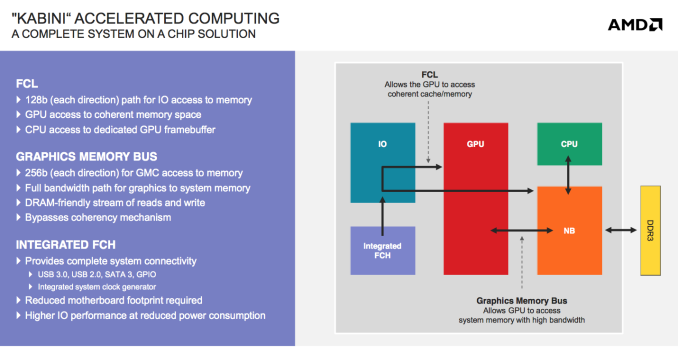
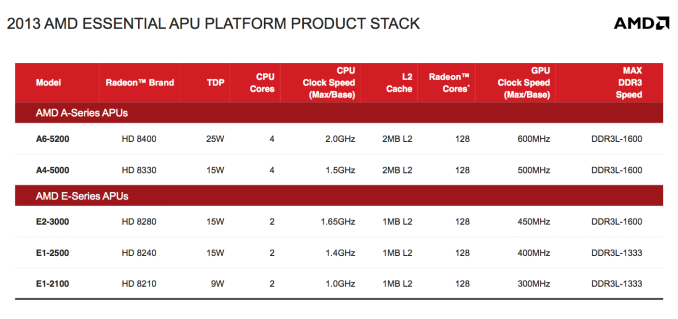
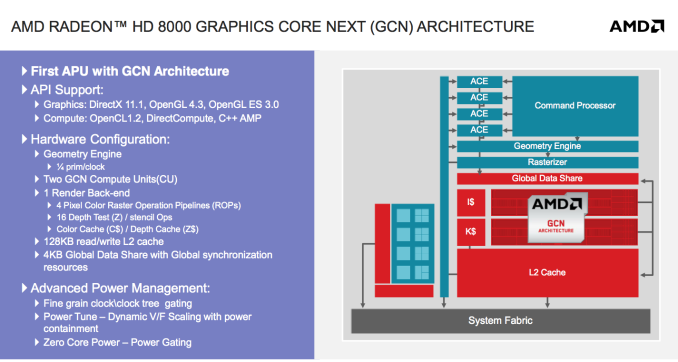
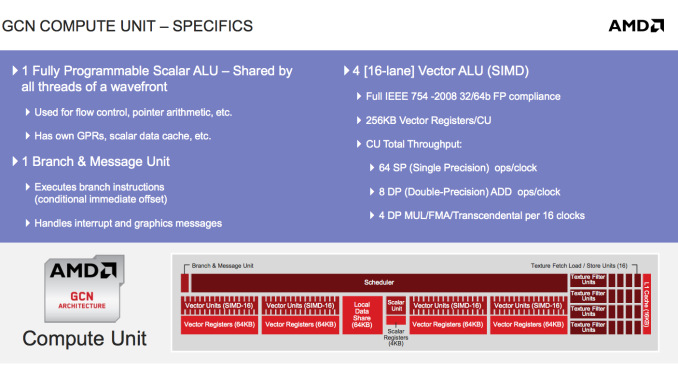
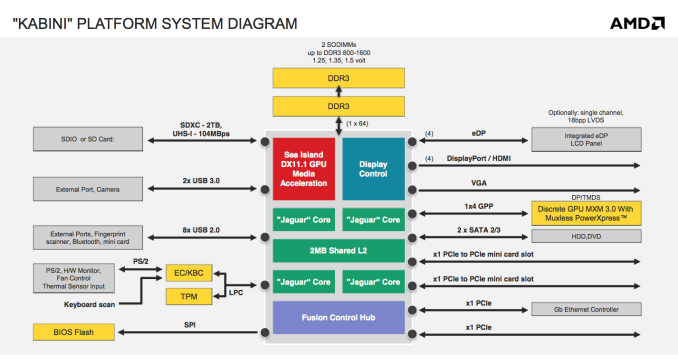
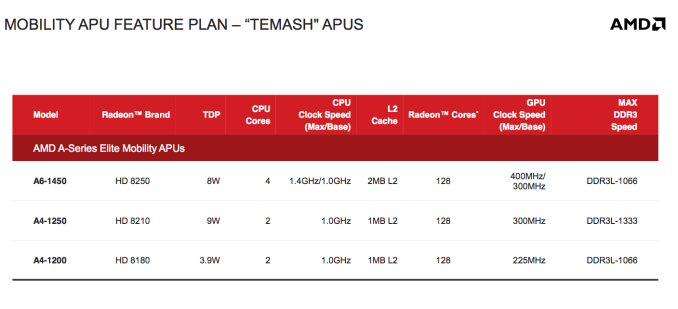
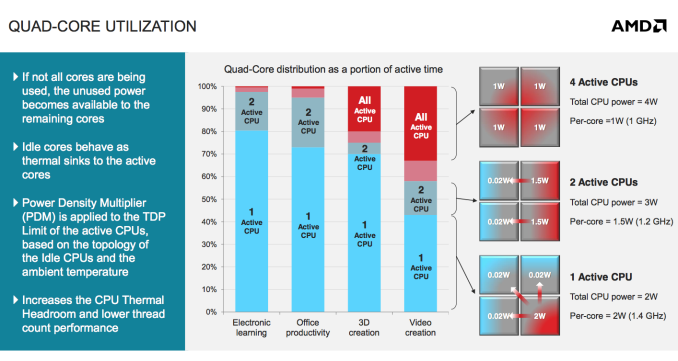








78 Comments
View All Comments
vision33r - Thursday, May 23, 2013 - link
Real shame is that AMD has not gotten into the mobile market at all. APUs like this would've been great for tablets.jeffkibuule - Thursday, May 23, 2013 - link
Even if AMD makes the chip, and OEM has to be willing to use it.duploxxx - Thursday, May 23, 2013 - link
exactly the problem, current atom is a horrible cpu in wathever device, whatever frequency you put it. have used them in notebooks and even now in a tablet. Bobcat on the other hand was awesome in the netbook range. THe temash would be way better suited for all these devices but as usual OEM focus on the blue brand with market jingles and dominancy and in the end its the end consumer (WE) that suffer from it and if it continues like this we will even suffer more. (less innovative, higher prices, dominant predefined design (something already horrible today) but many people fail to see that........as if they think there Intel system they just bought is a better suited device for everything...mganai - Thursday, May 23, 2013 - link
Intel's been going easy on AMD these past few years.Plus, Atom is finally due for its big update this year, following which we'll be seeing a more frequent update schedule in line with their Core processors.
The heterogeneous solution was what won the PS4 and XB1 for AMD.
thebeastie - Saturday, May 25, 2013 - link
Simple, Money! Why roll as fast as you can when your already the fastest and aren't going to be bringing any more money then you are now.Bobs_Your_Uncle - Saturday, May 25, 2013 - link
I'd read an interesting perspective on why Intel refrained from "kicking AMD to the curb & on down into the storm sewer" (sorry; can't recall the source). In essence, given the scope of Intel's unquestioned dominance in their chosen markets, (& mobile's on the radar), were they to act with any obvious & direct intent to further weaken, (or even try & finish off), AMD, Intel would find themselves in an extremely difficult, exceedingly complex & decidedly unpleasant set of circumstances.By decimating their only possible source of true competition, Intel would be responsible for invoking upon themselves intense anti-trust scrutiny; a result that would be inevitable assuming regulatory agencies were functioning properly.
By backing off a bit, Intel may well cede some amount of business to AMD, but they retain a legitimate market competitor & at the same time continue collecting very healthy margins. The premiums charged on sales can then be used to continue funding aggressive Intel R&D, and, uh, marketing related expenditures, too.
spartaman64 - Wednesday, June 4, 2014 - link
for a company that could "kick amd to the curb" intel is awfully nervous about amd's kaveriWolfpup - Wednesday, June 12, 2013 - link
Yeah, but regardless AMD's had the FAR better CPU now for years. I've been running the lowest end version of it for a couple of years in a tiny notebook, and from the beginning wished people were using it for tablets.Flunk - Friday, June 6, 2014 - link
When you say current Atom, are you referring to Baytrail? Previous Atoms were pretty bad for Windows boxes, in my personal experience. But the new generation is significantly more powerful (About on par with a Core 2 Duo on benchmarks). They seem pretty reasonable for basic office tasks, this may not include all the lowest-end versions.Flunk - Friday, June 6, 2014 - link
NVM, followed the wrong link and didn't see the date. Thought this was about something else. May 2013 Atoms sucked.